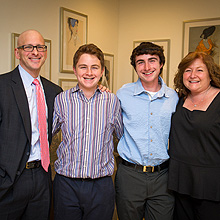Living with stage IV male breast cancer
Michael Selsman

When Michael Selsman came home from his morning jog, he noticed a lump on his chest. It was strange, because he'd never seen it before, but he figured it was probably just an irritation. A couple of weeks passed, and the lump grew larger. So Michael made an appointment with his doctor. The results were surprising — stage IV breast cancer.
"I was shocked. I'd never heard of men getting breast cancer. It took me a while to even drag myself to the doctor, because I didn't suspect that I had cancer."
It was 2011, and life was busy. Selsman and his wife Kara were working full-time, and their two teenage boys were thriving at school in their hometown of Sharon, Massachusetts. Selsman was unsure of how to tell his kids, but he decided the direct approach was best. Adam and Jacob were courageous when they heard about the diagnosis, and have been very supportive of their dad.
"The toughest thing was that I was diagnosed pretty late," he says. "If I'd been a woman, I'd have been more aware of the risk factors and family history, and that I was a candidate for breast cancer."
Selsman turned for treatment to the Male Breast Cancer Program at Dana-Farber/Brigham and Women's Cancer Center (DF/BWCC). Since only about 1,600 American men are diagnosed with breast cancer each year, it was important for
Selsman to be able to rely on DF/BWCC's strong experience with male breast cancer. His DF/BWCC team of breast cancer specialists is a leader in providing care and support for men with breast cancer — before, during, and after treatment. Selsman says DF/BWCC was an easy choice: "I spoke to family and friends who'd had experiences at Dana-Farber — everybody raved about the care," he says. "The doctors have been great. The people are so nice and helpful ... there's a lot of opportunity to consult with different people on different treatment options. I couldn't have asked for better care."
Knowing the symptoms, living with the treatments
"Even though men aren't screened for breast cancer the way women are, men should increase their awareness of this disease, and should look for changes and abnormalities of the breast and discuss these findings with their healthcare provider," says DF/BWCC breast cancer oncologist Beth Overmoyer, MD. Symptoms of male breast cancer can include a lump or swelling (which can be painless), skin dimpling or puckering, nipple retraction (turning inward), redness or scaling of the nipple or breast, and skin discoloration.
Staying positive
Selsman advises anyone who's been diagnosed to remain positive and resist getting frustrated or depressed. His biggest challenge has been dealing with the ups and downs of treatment.
Selsman is helping to raise awareness about male breast cancer, with a focus on early detection. He and his family lobbied for an official state designation to help the cause, and in 2012 Governor Deval Patrick signed a bill declaring the third week of October Massachusetts Male Breast Cancer Week.
"Men don't have the opportunities to find breast cancer during a routine check-up like women do," Selsman says. "I want to change that, and save other families from the pain and challenge of living with stage IV male breast cancer."

